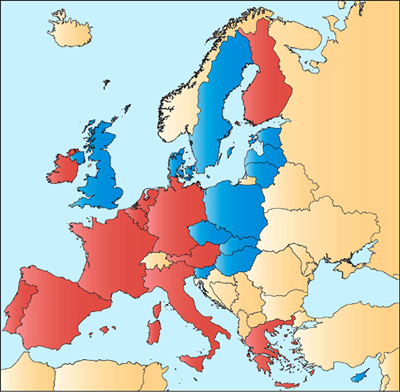Regional integration is the process by which two or more nation-states agree to co-operate and work closely together to achieve peace, stability and wealth.
Usually integration involves one or more written agreements that describe the areas of cooperation in detail, as well as some coordinating bodies representing the countries involved.
This co-operation usually begins with economic integration and as it continues, comes to include political integration. We can describe integration as a scale, with 0 representing no integration at all between two or more countries. Ten would represent complete integration between two or more countries. This means that the integrating states would actually become a new country — in other words, total integration.
We could also say that on the table below, 1-4 represents economic integration while 6-10 represents political integration. The halfway stage, 5, represents the single market, or the completion of economic integration.
| 0 |
5
|
10
|
| No integration |
Single Market
|
Total Integration
|
| Economic Integration |
Political Integration
|
Key Terms:
Economic integration is the process by which different countries agree to remove trade barriers between them. Trade barriers can be tariffs (taxes imposed on imports to a country), quotas (a limit to the amount of a product that can be imported) and border restrictions. For example, Canada, Mexico and the United States have formed the North American Free Trade Agreement (NAFTA), which reduces trade barriers between the three countries. On the integration scale NAFTA, would be at about 2 since Canada, the U.S. and Mexico are still free to set their own trade barriers on goods from other countries.
The single market is the midpoint of the integration scale between political and economic integration. It is the point at which the economies of the co-operating states become so integrated that all barriers to the movements of labour, goods and capital are removed. At this stage the integrating states set a common external tariff on goods from other countries–this is called a customs union. A further step in the process of economic integration might be adoption of a common currency, with monetary policy regulated by a single central bank.
Political integration: As the economies of the co-operating countries become completely integrated into a single market, there appears a need for common policies in social policy (education, health care, unemployment benefits and pensions) and common political institutions. This is political integration and its culmination occurs when the co-operating countries are so integrated that they share the same foreign policies and merge their armies. In effect, they form a new country.
Sources: John McCormick. The European Union: Politics and Policies. Westview Press: Boulder Colorado, 1999.
So what is the European Union and where does it lie on the integration scale?
